

| It was the Sixties, of course, in a town usually thought
of in terms of Mario Lanza, Chubby Checker, Bandstand and Doo-Wop rather
than hard nuts Rock & Roll. Unfairly, of course, as any fan of Todd
Rundgren and/or the Nazz would be quick to point out.
Nevertheless, The Doo-Wop aspect of Philly cannot be overlooked. Local Doo-Wopp wannabes were well known for singing the songs of the Coasters and the Duprees on street corners, in buses or (best of all) in an El station. Big stairwells, lots of echo. It was something of a cottage industry. Sing and get discovered. And though it rarely happened, Philly kids never seemed to get discouraged. Having said that, when the Beatles made their first appearance on The Ed Sullivan Show in 1964, there were more than a few young Philly ears that perked up to the new sound. By the following year, the times, they were a'changin. This is the short story of several sets of those ears. | |||||||||||||
|---|---|---|---|---|---|---|---|---|---|---|---|---|---|
|
|||||||||||||
| Ed Murray and Mike Frederick, as true Philly boys, were no exception to the
Doo-Wop thing. They were both students at Father Judge High School. Mike
entering his senior year; Ed, his junior. And in keeping with the best of
city traditions, they hung out with their friends on street corners. In a
development called Morrell Park in the Northeast. (Northeast is always
capitalized in Philadelphia. There it is a place, not a direction.) Often
singing along with a transistor radio. Just as often, without it.
Appreciated or not, they had developed a small reputation for their singing
and interest in music.
They also happened to be altar boys. The new Christ the King Parish opened their church on Morrell Avenue in 1965. The new building included a shinny new recreation hall complete with a wall mounted, tilt down turntable and overhead speakers. Interested in improving participation, the pastor decided it would be a great idea for the church to host dances for the local teenagers. Naturally, they needed someone to MC the dances. It wouldn't fly for a nun or a priest to do it. They needed someone who knew popular music and wouldn't be shy in front of a crowd. What about those two altar boys, Ed and Mike? Morrell Park in the early sixties was something of a frontier. Not that you could tell by looking at it today. Now it looks like a bunch of cardboard houses all jumbled together. In the sixties, it was a cluster of brand new, bright white row homes on a steep wooded hill overlooking Frankfort Avenue and City Line. (Also capitalized in Philly.) There was one lonely strip of a shopping center on Morrell Avenue with one sandwich shop, "The Goal Post". So the idea of a Friday night dance was pretty much a guaranteed hit in a neighborhood with few amenities. While Ed and Mike busied themselves singing on the corner and MC-ing the dances, several other neighborhood boys -- who ears had been perked up earlier by the fore mentioned Beatles (the Who, the Kinks, the Stones, etc.) - busied themselves learning how to play drums and guitars. As predicted by the Law of Musical Gravitation, several formed themselves into a band which, as you might expect, also garnered a small measure of local notoriety. Partly because they had the loudest garage around and partly because there simply weren't that many bands in the sticks of Morrell Park. So it was only a matter of months before the band began to play at the church dances. And even less time before the band would invite Ed and Mike up to sing a couple of songs. So it was that at one of those dances that guitarists Ray Rudnitskas and Mike Bell approached the two MCs with the idea of forming a new band. The plan was simple. Loose some deadwood, keep the drummer, Dave Snyder, and add vocalists. Deal. They were a band. Still a garage band, to be sure, but a band nonetheless. They played the church dances, parades (in any weather), any place they had the chance. They acquired management in the form of Tony Lazarus. Maxine, Tony's wife, became a den mother of sorts. They settled on a name. Mike Bell who got his inspiration from the Rolling Stones album "High Tides and Green Grass" suggested the "Rising Tydes" More dances. Another parade. Ray worked hard at his licks. DJ dances. Mike Bell bought a Gretch Country Gentleman. More DJ dances. The band got tighter. Battles of the bands. Dances. |
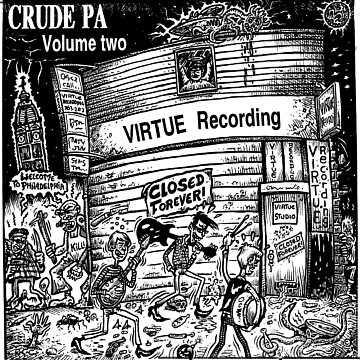
Distortions Records, Bala Cynwyd, PA |
||||||||||||

|
|||||||||||||
|
|||||||||||||
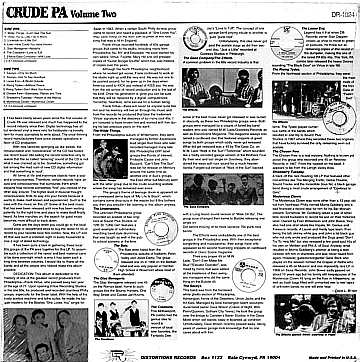
DR-1024, copyright 1996 |
It was the year Mike Frederick graduated from Father Judge and went to work.
Perhaps it was that he was no longer a high school student. Perhaps it was
the band's frustration with their imagined lack of progress. Perhaps it was
just a feeling of stagnation that led the other members to decide they
really didn't need more than one vocalist. (Which never fazed the Soul
Survivors.) Mike was told he was out. Room was thus made for a bass player.
It was also the year Mike went to work full-time. Which meant he made money. Which meant he could spend it. Which he did. With one of his first paychecks from Bell Telephone, he promptly marched off to a music store in the Mayfair section and bought a cheap bass guitar, an even cheaper amp and a Mel Bay book. And went home to learn. A few months later, Mike stopped at Tony and Max's house to say hello and see how the band was coming along. (As if he didn't know.) During the conversations, he picked up the other guy's bass that was lying there and played a couple of riffs. The others seemed a bit surprised that he had picked up this new skill. After a short consultation between band members (including Mike Bell's appraisal of their current bassist as "sucks"), they had a new bass player -- and their old "extra" vocalist back. Bob Derer, another Father Judge senior, joined the Tydes on keyboards bringing the body count to six and rounding out the sound. But there was still one more change was in the offing. Drummer Dave Snyder's favorite thing in the world seemed to be his passion for playing along with the Tonight Show's intro music. Something that had always made him suspect with a band who held the opinion that Doc Severson was not much different than Gregorian Chant. Perhaps worse. So Dave was dropped as the drummer and replaced by Mike Frederick's cousin, Ronnie Spering. |
||||||||||||
|
|||||||||||||
| Sixty-seven! Ah, that was the year!
With a deal somehow put together by Tony the Manager, the band made a mad night trip to Sound Plus, a small, second floor recording studio. Hauling their equipment up and down a long, narrow flight of stairs. After as many takes as they could afford, they completed two original songs: "Artificial Peace" (actually it was titled "Apathetic World" but it got changed somehow along the way) and "Don't Want You Around". Enough for a 45. Cool! It was the year the Tydes began to appear on television promoting their record. Local shows hosted by local DJs like Jerry Blavit. Then there was that trip to Atlantic City for an appearance on Ed Hurst's TV show "Summertime on the Pier". They "co-stared" with Buddy Rich and Brenda Lee. It was one of Ronnie's proudest moments when Buddy Rich took the time to compliment him on his drumming. Brenda Lee wasn't much more than polite. They weren't overly impressed with her either. More Dances. Hi Lit. Jerry Stevens. Bob Derer left the band and was replaced by Bill Byer. They played in Fairmount Park at the first city sponsored rock concert ever held in a Philadelphia park. They appeared in the April issue of Discoscene Magazine. They were on the move. It was also the year reality set in. Mike Frederick turned eighteen that January. A year short of nineteen. A year short of the draft. In the dawn of the Vietnam "Era" when Washington had yet to dream up the lottery. After your nineteenth birthday, you simply went home and checked the mail each day for a letter that began "Greetings, You have been selected..." Then you packed your bags and left. Either for basic training or Canada. |
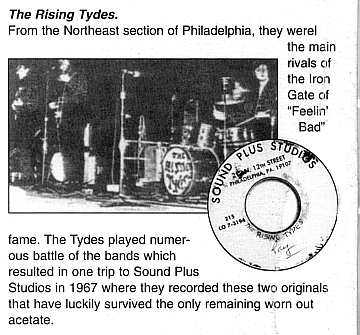
MIKE FREDERICK ~ RAY RUDNITSKAS ~ RONNIE SPERING |
||||||||||||
|
|||||||||||||
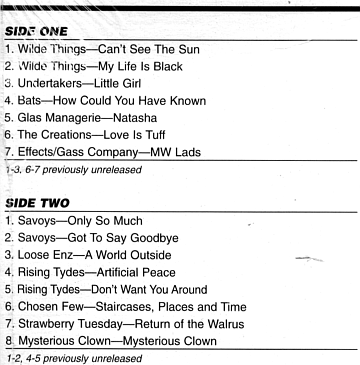
|
Rather than be drafted into the Army (who had threatened to make him
a helicopter pilot), Mike volunteered for the Air Force. On a snowy day in
early January, he said goodbye to Philly and left for Lackland Air Force Base.
As a group, they only saw each other once more after that. Mike was on leave about a year later and the band was playing the Electric Factory. With another bass player, of course. A bitter sweet reunion for Mike. Them on a stage, he in a uniform. The band continued to play the local circuit for a time but jobs, marriages, kids, bills and life in general took it's inevitable toll on the dream. The Rising Tydes never released another recording. |
||||||||||||
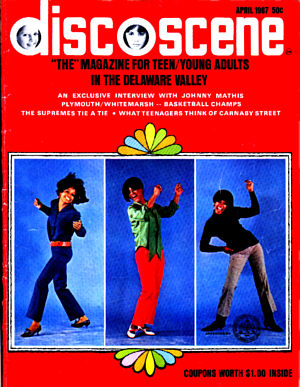
|
|||||||||||||
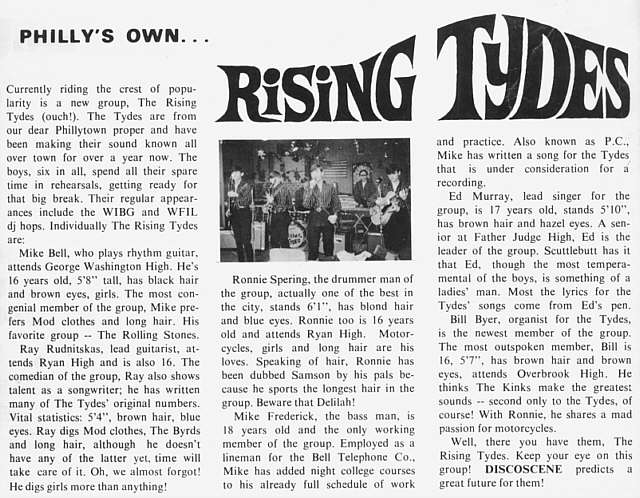
|
|||||||||||||
|
|||||||||||||
|
|||||||||||||
| In 2002,
in an idle moment and for no particular reason, I typed "Rising Tydes" into Google. Remarkably, several hits come back. A few compilations of the names of long forgotten garage bands and an advertisement for an album called "Crude PA, Volume 2". THAT caught my eye. An album including those two ancient Rising Tydes recordings. From a company called Cranium Music in New Zealand. Of all places! Amazing. Unfortunately, Cranium said it was "out of stock". (Ha! Like the next delivery would be in a week or so.) So for the next year, I tried to locate a copy. Nothing on eBay. Nothing new in Google. Then one day, a reference to a site called GEMM comes up listing a copy for sale by a fellow in England named John. England! Geez! Seems the Tydes might have been better known overseas than they were here. Go figure. |
So I buy the album and it comes in brand new, still shrink-wrapped. The cover says it was put out by Distortions Records of Bala Cynwnd, PA. Extensive liner notes on the dozen bands with a great introduction all written by a David L. Brown. More searching. Following a reference in CityPaper.Net, I finally track down Mr. Brown. We trade several emails, reminiscing about the Tydes, the times and how he came across the recording. Seems he got a hold of it from someone who still had a copy - Ray Rudnitskas. Begin singing "It's a Small World After All" now... Small bit of trivia: The pictures of the band used on the album and in the Discoscene article were both taken the same day in a empty storefront in that little shopping center on Morrell Avenue. Mike Frederick, June, 2003 |
||||||||||||
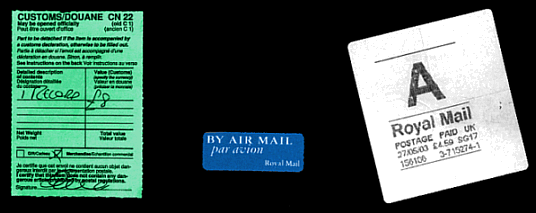
|
|||||||||||||
| David L. Brown pressed a thousand copies of "Crude
PA, Volume 2" in the mid-nineties.
He has about 25 copies left and said he may put them on eBay someday. David is still in the Philadelphia area and is the man behind "Philly Music Archives" which specializes in re-releases of Philadelphia's 50s and 60s soul music. Guess where they're popular? England. His current offerings can be found at PhillyMusicArchives and at Distortions Records | |||||||||||||
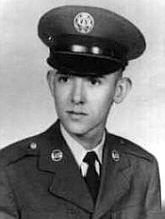
|
|||||||||||||
|
After serving in the US, Southeast Asia, Europe and North Africa, Mike Frederick left the Air Force in December 1974 and settled in Harrisburg, Pennsylvania. He now lives in Tampa, Florida where he is a computer systems engineer for a large government organization. Mike still plays guitar and sings in a band called The Leo Toffard Project and has a very substantial pile of electronics in his garage. 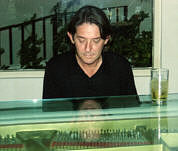
~This is certainly his own recollections of thirty-plus years ago.Ed, Ray, Mike, Ronnie, Bill and other interested parties are invited to send corrections to Mike Frederick | |||||||||||||
BREAKING NEWS!Ray Rudnitskas checks in on July 7, 2003
|
|||||||||||||
AND MORE...Read 60sGarageBands.com's interview |
|||||||||||||
| Home: The Leo Toffard Project | |||||||||||||